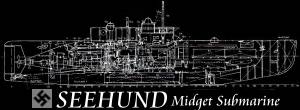 |
|
|
|
| Seehund Type XVII B5 (127) Specifications |
|
|
| More Technical Description about the Seehund |
|
The high
performance of midget U-boats and their G7e electric torpedoes was closely
related to the development of new battery types. In December of 1944, U6251
and U6252 were to have been fitted with the so called Primärbatterie,
a set of galvanic rechargeable cells, first proposed during 1926-1936. It
was not until 1943, however, that the new type of battery eventually
attracted some attention and was test fitted to the G7e torpedo. Trials
with the modified weapon designated as Gerät 42 All were carried out
between Aug. 25 and Sept. 12, 1944. The battery was of the Mg-C type (magnesium-carbon). An electrolyte reservoir and an impeller pump enforced a constant flow of electrolyte in the cells, which in turn improved the power storage capacity and significantly increased the speed and range of the standard G7e. In early 1943, Prof. von Steinwehr or PRT (Physikalisch-Technische Reichsanstalt) in Berlin submitted plans for a simpler galvanic battery utilizing the Zn-PbO2 system. The system was nothing new but, when it was suggested in the '30. no use was found for a high capacity battery unable to store power for long periods of time. With the advent of the electric torpedo, this battery was exactly what was needed. Both the Mg-C and Zn-PbO2 torpedoes were filled with electrolyte prior to launch. The 13 Zn-PbO2 cells ( in two Tröge) in the standard G 7e battery space were replaced with 18 Zn-PbO2 cells. The advantages were obvious : the output of the torpedo motor was increased by 70% and the range was extended to 10,700m at 30 knots. Being thinner, the new cells were also manufactured using 30% less lead. The firm of Varta AG was to receive the manufacturing contracts for this type of battery, which was also to be used in the Goliat self propelled mines. Work was also in progress on other galvanic systems such as zinc-nickel oxide potash lye, cupric oxide zinc potash lye and silver zinc. A pair of Seehund was to be provided with metal chlorine batteries containing platinum carbon cells and zinc electrodes (dimensions : 400 x 230 mm). An impeller pump supplied a steady flow of electrolyte in the form of a distilled water solution with a 5% admixture of hydrochloric acid. Whenever necessary , the electrolyte could be enhanced with Chlorine. The Seehund could be equipped with four batteries of this kind, a total of 120 cells operating at 90V with a maximum current intensity of 110 amps. This configuration was to produce a constant output of 20 KW, or 1000 KW-hours. The impeller pump, manufactured by the company of Garvenserk in Wien, constituted the most crucial element of the whole system. During a period of 50 hours (the duration of one petrol), the chlorine resistant device had to pump through it the entire supply of electrolytes, 481 liters, seven times. The installation in two Seehund was to get underway in late 1944, but neither of the craft was ready to sea before the war's end. |
|
Notes : Physikalisch-Technische Reichsanstalt : The idea of creating the Physikalisch-Technische Reichsanstalt (PTR) dated back to Schellbach's exposé entitled "Über die Gründung eines Museums für die exakten Wissenschaften" (On the Foundation of a Museum for the Exact Sciences) published in 1872. However, it was the endeavors of the industrialist Werner von Siemens from 1882 onwards – and the gift of a building site in particular – that ultimately led to the foundation of the "Physikalisch-Technische Reichsanstalt für die experimentelle Förderung der exakten Naturwissenschaften und der Präzisionstechnik" (Imperial Physical Technical Institute for the Experimental Advancement of the Exact Sciences and Precision Technology). The institute was founded by a VARTA AG : |
|
|
